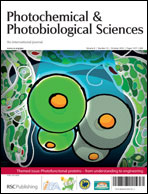Exposure to light has been implicated as a risk factor during aging of the eye lens and in cataract generation. In order to visualize the actual effect of UVA-visible light on this tissue, we incubated water-soluble eye lens proteins with ascorbate in the presence and absence of UVA-visible light for 3, 6 and 9 days at low oxygen concentration. The samples incubated in the presence of light were characterized by an initially small but continuous increase over time of the protein crosslinking. This was not the result of more extensive glycation because the decrease in amino group content of the proteins and the decomposition of ascorbate was the same in both irradiated and unirradiated samples. The augmented crosslinking capacity observed in the presence of UVA-visible light is due to the generation of a chromophore from the decomposition of ascorbate. This chromophore, obtained after 3, 6 and 9 days of incubation of solutions containing only ascorbate, induces both protein-crosslinking and oxidation after exposure to UVA-visible light in the presence of lens proteins. The extent of the crosslinking was proportional to the amount of the chomophore present in the solution. The presence of this chromophore was also determined when ascorbate was incubated with four-fold higher concentrations of N-α-acetyl lysine and N-α-acetyl arginine. When these samples were used as photosensitizers, the crosslinking degree was conditioned by the presence of this chromophore; nonetheless, the ascorbate-mediated advanced glycation end product (AGE) generation also made a contribution. The results of this work indicate that ascorbate oxidation, which generates the AGEs responsible for the chemical crosslinking of the lens proteins, also simultaneously produces a chromophore that can act as a photosensitizer, further increasing the protein crosslinking.

You have access to this article
 Please wait while we load your content...
Something went wrong. Try again?
Please wait while we load your content...
Something went wrong. Try again?


 Please wait while we load your content...
Please wait while we load your content...